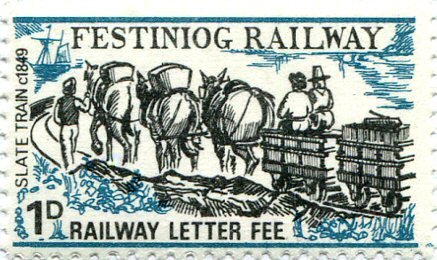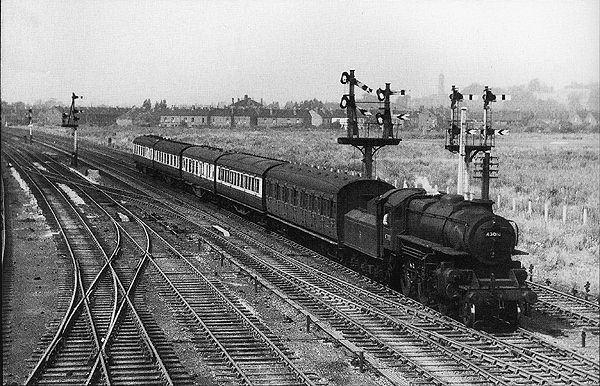Stamp: Horse-drawn slate train c. 1849 (Personalized and Private Mail Stamps 1969)
Horse-drawn slate train c. 1849 (Personalized and Private Mail Stamps 1969)
28 May (Personalized and Private Mail Stamps ) within release United Kingdom : Festiniog Railway goes into circulation Stamp Horse-drawn slate train c. 1849 face value 1 British penny (old)
| Stamp Horse-drawn slate train c. 1849 in catalogues | |
|---|---|
| Colnect codes: | Col: UK-FER 1969-01/01 |
Stamp is square format.
• Designer: Michael Seymour. • Printer: T. Stephenson & Sons, Prescot. • Sheets of 12 stamps (4 rows of 3 stamps). • Perforations: 11, 11ź and rough. Number Printed: • 28th May 1969: 12,000 (Sheet numbers 00001-01000) - perforation 11. • 1st July 1969: 13,200 (Sheet numbers 01001 - 02100) - rough perforation. • 13th August 1969: 16,800 (Sheet numbers 02101-03500) - perforation 11. • 15th November 1969: 6,000 (Sheet numbers 03501-04000) - perforation 11ź.Also in the issue United Kingdom : Festiniog Railway:
- Stamp - F.R. 0-4-4-OT No. 10 Merddin Emrys and train face value 1'2;
- Stamp - Horse-drawn slate train c. 1849 face value 1;
- Stamp - Portmadoc with Mountaineer and train, c. 1870 face value 6;
- Stamp - The Twenties, No.2 Prince with Bullnose Morris car face value 1;
Stamp Horse-drawn slate train c. 1849 it reflects the thematic directions:
The horse (Equus ferus caballus) is one of two extant subspecies of Equus ferus. It is an odd-toed ungulate mammal belonging to the taxonomic family Equidae. The horse has evolved over the past 45 to 55 million years from a small multi-toed creature, Eohippus, into the large, single-toed animal of today. Humans began to domesticate horses around 4000 BC, and their domestication is believed to have been widespread by 3000 BC. Horses in the subspecies caballus are domesticated, although some domesticated populations live in the wild as feral horses. These feral populations are not true wild horses, as this term is used to describe horses that have never been domesticated, such as the endangered Przewalski's horse, a separate subspecies, and the only remaining true wild horse. There is an extensive, specialized vocabulary used to describe equine-related concepts, covering everything from anatomy to life stages, size, colors, markings, breeds, locomotion, and behavior.
Railways - Transportation system made up of metal rails which is designed to allow trains to maneuver on the tracks from one location to the next.


